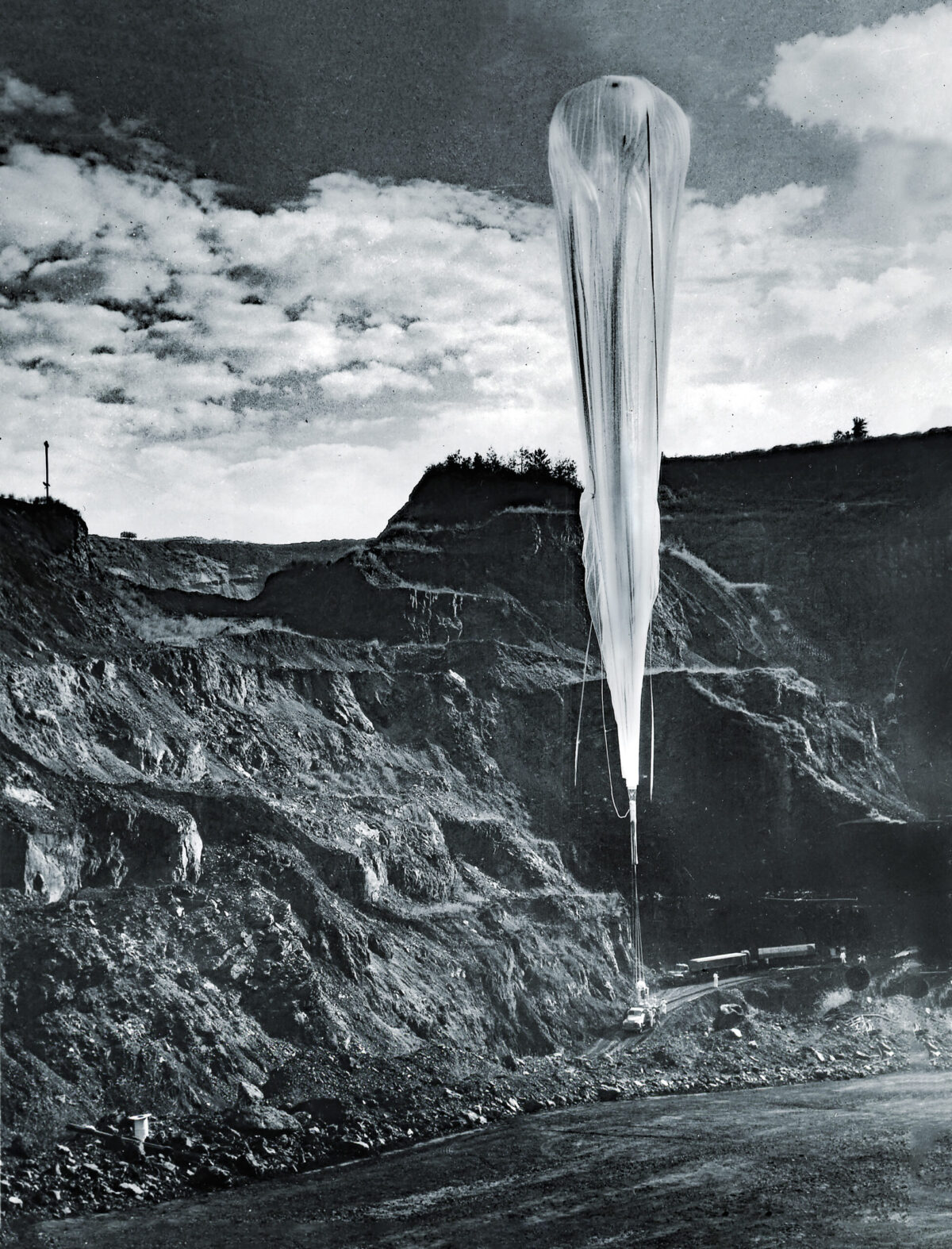Before humans flew into orbit—even before an artificial satellite circled the earth—an American program put people at the threshold of space, 19 miles above the earth. They made their dangerous ventures into the unknown aboard sealed containers suspended from balloons, and experienced conditions that were virtually the same as those in outer space, with practically no air pressure and a temperature of minus 90 degrees Fahrenheit.
The program was Manhigh. It received international press coverage, with its second flight featured on the cover of the September 2, 1957, issue of Life magazine. Then, about a month after the Life article, the Soviets launched Sputnik 1, the starting gun for the space race. Manhigh was quickly overshadowed by Vanguards, Explorers and additional Sputniks even before its nearly disastrous final flight in late 1958.
Project Manhigh’s purpose was to study the physiological stresses of high-altitude flight on the human body and the effects of cosmic rays. Cosmic rays are highly charged, extremely powerful nuclear particles that move at nearly the speed of light and typically originate from millions of light years away. The earth’s upper atmosphere filters out these rays and keeps them from striking the surface. Airplanes of the future were expected to reach altitudes of up to 100,000 feet, and no one knew the dangers of sustained flight at those heights—perhaps blindness or cognitive impairment. Scientists and the military, already thinking ahead to the time when humans would venture into outer space, wanted to know the risks.
Investigations of cosmic rays on living cells by the U.S. Air Force in the early 1950s sent balloon-borne instrument packages and small animals as high as 90,000 feet for hours at a time. Aerobee and V-2 rockets launched animals to even greater altitudes. These tests provided some evidence that cosmic radiation would not necessarily be a barrier to high-altitude flying. For example, two monkeys exposed to cosmic rays for a total of 60 hours on two separate balloon flights showed no apparent learning difficulties. Mice experienced significant graying of their fur after their flights, but showed no other ill effects.
In 1955 Major David G. Simons, MD, was the chief of staff of the Space Biology Branch of the Aeromedical Field Laboratory at New Mexico’s Holloman Air Force Base. His previous work had included studying the effects on animals launched to the edge of space in V-2 rockets. According to Simons’s 1960 book, Man High, Colonel John Paul Stapp, a fellow MD and aeromedical researcher, approached him sometime that August. Stapp, who had become known as “the fastest man on earth” after using rocket sleds to experience the effects of high acceleration on humans, surprised Simons by asking him, “Do you know enough now to replace your animals with a man?” Simons, without hesitation, replied, “A man, sir? I know we can!” Then Stapp asked, “Would you be afraid to take the flight yourself?” Simons said he was not. “I was confident,” Simons wrote. “But I also knew there was a broad belt of ignorance surrounding the knowledge we had gained from the animal flights.” Furthermore, research by a Swiss doctor had indicated that cosmic rays could indeed pose a danger to humans.
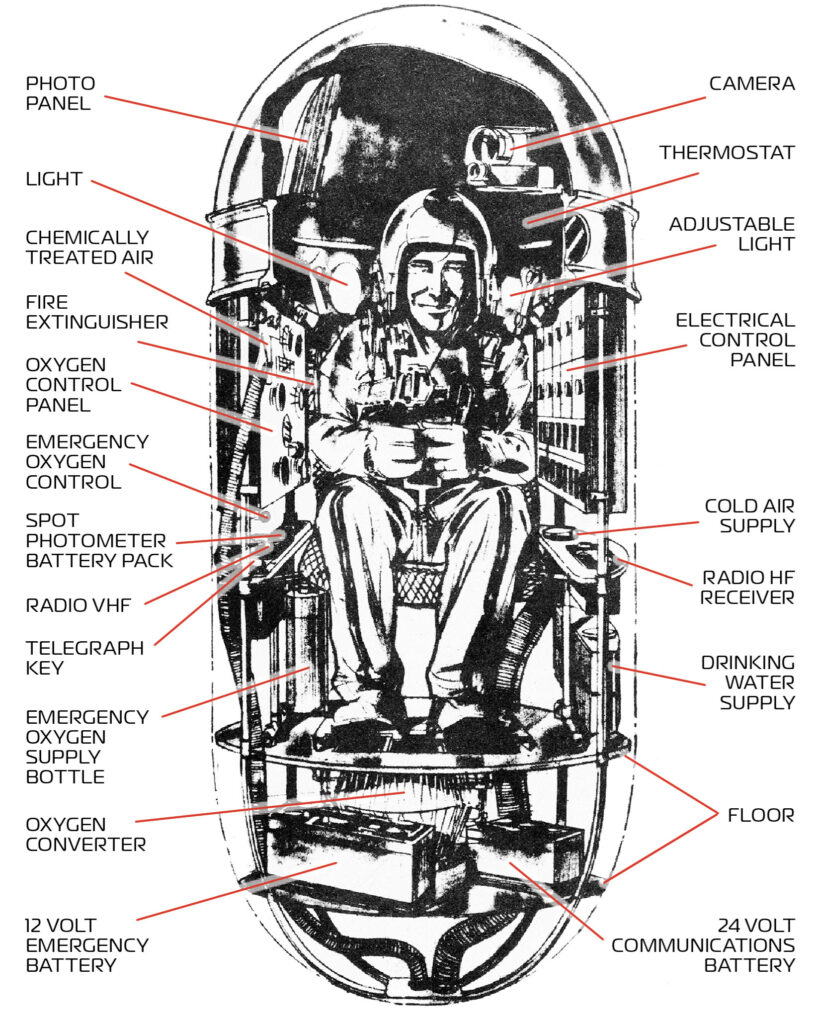
Winzen Research, Inc., a company near Minneapolis, Minnesota, received a contract to create what amounted to a virtual spacecraft, a gondola that would be suspended from a polyethylene balloon. The small company was run by Otto Winzen and his wife, Vera. They had already been building and launching animal-research capsules for Simons.
Polyethylene, developed in the late 1940s, was superior to the much heavier rubber materials used in the past and was also cheaper to manufacture. Vera trained her team of so-called “balloon girls” to carefully assemble the long strips of polyethylene into a balloon using a heat-sealing process. In between the balloon and gondola was a 40-foot-diameter escape parachute that could be used in an emergency.
The aluminum gondola, essentially a cylinder with heat-treated cast aluminum domes at top and bottom, was composed of three sections fastened together with clamps that could be released electrically or mechanically. It was insulated with alternating layers of honeycomb paper and aluminized Mylar. Communications were through a VHF transceiver for primary voice communication; a high-frequency (HF)transceiver for telemetry (data transmission) and an emergency communications channel; and a telegraph key for backup. To maintain contact with the gondola, a communications van, three helicopters and two Douglas C-47 Skytrains followed the balloon’s flight path. A chemical air regeneration system removed the carbon dioxide and water exhaled by the pilot from the gondola. The pilot wore a partial-pressure suit (in case of depressurization) with special plates attached to the arms to record strikes by cosmic rays. Sensors attached to the pilot’s body transmitted his biomedical information to medics throughout the flight.
Pilot candidates for Manhigh had to pass an extensive physical exam and a 24-hour claustrophobia test to make sure they could tolerate the long missions in the cramped capsule. They also had to qualify as Civil Aeronautics Administration licensed balloon pilots. Balloon qualification required six low-altitude flights. These flights used an open-gondola Sky-Car system designed by Winzen.
Before the first manned flight, the program conducted several test flights of the Manhigh systems, often with mice, hamsters or guinea pigs on board. The life support systems and the emergency 40-foot parachute passed their tests. On one of the flights, though, the balloon shattered and wrapped around the gondola and the emergency parachute. The gondola plummeted to the ground.
For Manhigh I, Stapp recognized the need to have an experienced pilot who could test the systems in flight. Captain Joseph Kittinger Jr., a U.S. Air Force fighter pilot, had worked with Stapp on his rocket sled tests after coming to Holloman’s Air Force Missile Devel-opment Center in 1954. Stapp had been very impressed and personally asked the director of the Holloman Flight Test Division for Kittinger to become a part of Project Manhigh.
Preparations for the launch of Manhigh I got underway at Winzen Research on the night of June 1, 1957. Kittinger received a preflight physical, had medical sensors attached and put on his MC-3 partial-pressure suit. Meanwhile, a USAF crew, along with Otto and Vera, prepared the gondola for flight. That included loading five liters of liquid oxygen into onboard tanks and checking the electrical and communications systems. Despite the care that had been taken toward making the Manhigh systems ready for flight, one hazardous defect escaped unnoticed until later in the mission.
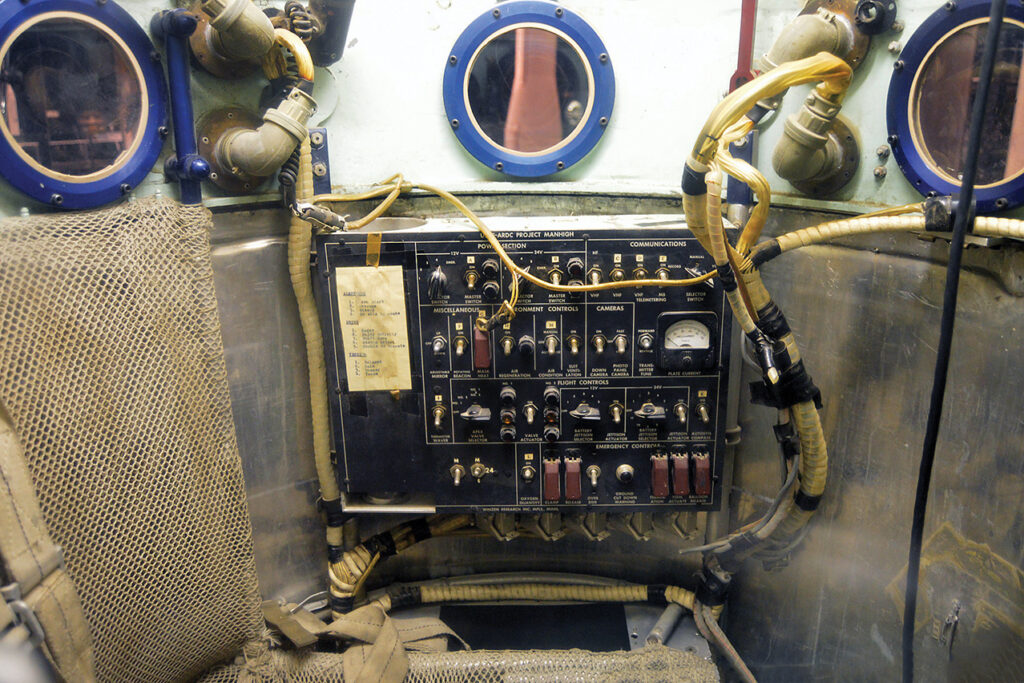
Kittinger entered the gondola at 12:30 a.m. and endured several more hours of systems checks. Some three hours later a truck took the gondola on the 50-minute drive to Fleming Field in South St. Paul, Minnesota, for the launch. Several tracking and photographic aircraft were already aloft when two million cubic feet of helium pulled Manhigh I up from its launching platform at 6:23 a.m. Soon into the flight, the channel selector knob for the VHF system failed, forcing Kittinger to rely on the HF system to receive instructions and laboriously tap out Morse code to relay messages.
As he reached 45,000 feet, Kittinger felt the 100 mph winds of the jet stream, just as Manhigh’s project meteorologist, D.B. “Duke” Gildenberg, predicted he would. “Sure enough, the instant I hit the jet stream, I was hammered,” Kittinger said. “The capsule went over almost 90 degrees…. There wasn’t much I could do but sit tight and wait…” He knew this was the point where most balloon failures occurred, when the polyethylene got brittle in the frigid cold at high altitude. Those watching with instruments on the ground could see the winds warp the balloon. Fortunately, it held together and resumed its normal shape after getting above the jet stream. “Vera and her balloon girls had done themselves proud,” said Kittinger.
Manhigh I reached its apex, 96,000 feet, at 8:07 a.m. Kittinger reported on his status; when he got to the twelfth item on the checklist, oxygen supply, he realized the gauge showed that half of his supply was already gone. “I knew right away I was in a world of hurt,” Kittinger said his 2010 book, Come Up and Get Me. He turned off his cabin oxygen supply “and started bleeding oxygen into the capsule from the supply in my pressure suit.” Less than 50 minutes after reaching maximum altitude, with his oxygen supply low, and the ground team quite concerned, Kittinger received orders to start his descent. He did not need to be told, as he was already valving gas.
At 12:55 p.m., Manhigh I touched down in high winds at Indian Creek, just north of Weaver, Minnesota. The landing came just in time: Kittinger’s oxygen supply was depleted. Stapp and Simons had already left their ground station in a helicopter and were present when Kittinger landed. Simons helped the elated pilot out of the capsule. Stapp later told the press, “Not a red hair of his head had turned grey.” Kittinger had no ill effects from cosmic rays.
Once the gondola was back at Winzen Research, it quickly became apparent what the problem was: someone had mistakenly reversed the oxygen and vent hose connections, so the oxygen had been vented outside. The VHF failure was due to a loose switch.
After multiple aborts due to weather, Manhigh II was set for launch on Monday morning, August 19, 1957. With Kittinger back at Holloman for another assignment, Simons would be the pilot. Meteorologist Gildenberg evaluated the weather conditions. The weather was good for launch, but he was not so sure about the weather the next day for the descent. There was a chance that a severe thunderstorm could pass beneath Simons’s flight path. After that, the weather was not expected to be suitable again for three weeks. Making the flight under those conditions would be a gamble, but money for the program was tight and another delay could mean canceling the flight altogether. The decision was made to go forward.
Manhigh II’s thinner 1.5 mil (one one-thousandth of an inch) balloon was not suitable for a surface launch this time, so the launch point was shifted to a sheltered spot at the bottom of an open pit iron mine in Crosby, Minnesota. The larger balloon, filled this time with three million cubic feet of helium, took off at 9:22 a.m., the swinging gondola just clearing the mine walls.
The ascent was normal and this time the jet stream was mild. By 11:40 a.m., Simons had soared to a Project Manhigh record altitude of 101,516 feet, higher than any manned balloon had gone before. He radioed to those monitoring his flight, “I have a ringside view of the heavens. It is indescribable.” He began the 25 planned experiments, such as observing Venus and the aurora borealis and monitoring cosmic rays.
Hours after reaching the peak altitude and with night approaching, Simons realized his performance was getting sluggish. His last real sleep had been 24 hours previously and he had not eaten. He scarfed down a chocolate bar, hoping the increase in his blood sugar would help his concentration. At twilight Simons noted his altitude had dropped. This was normal, as the helium cooled at night, but his altitude continued to drop over the next few hours. The thunderstorm Gildenberg had noted had moved rapidly and was now underneath Simons, who could see clouds boiling up to 50,000 feet or more. Looking out a porthole, he saw lightning, “a flashing neon display.” This might be what was causing his descent, he thought.
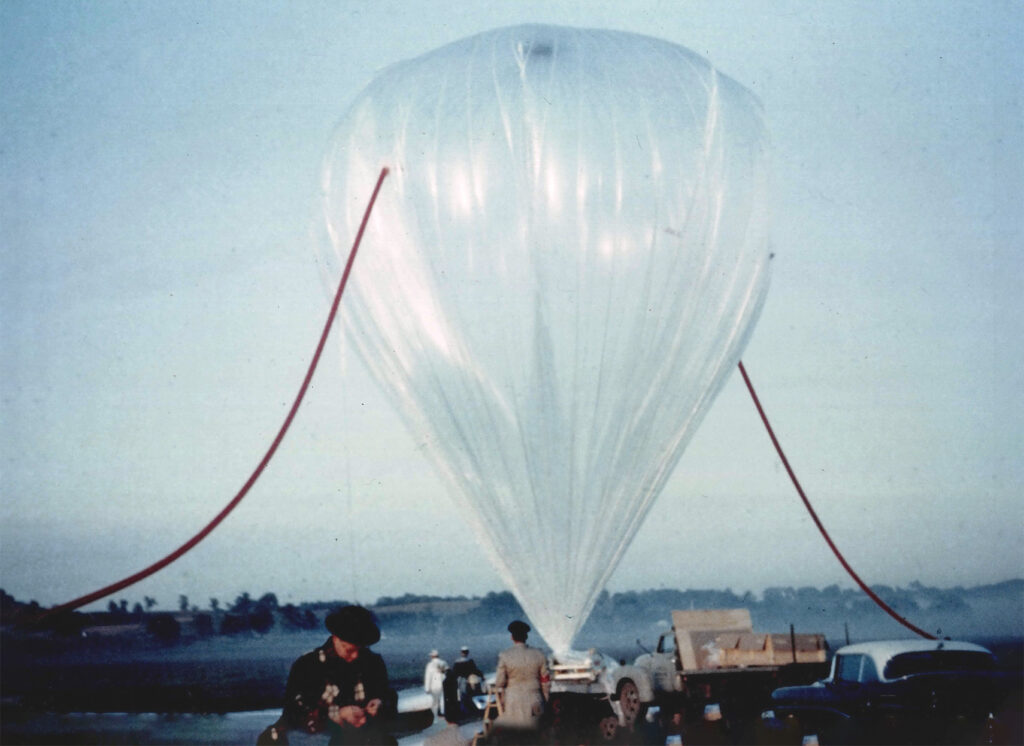
Simons calculated he would soon fall to 70,000 feet, so he dropped some ballast, hoping to slow the descent. He was exhausted and needed sleep, but he only managed a half-hour nap. He was at 71,800 feet when he awoke, but quickly descended to 70,000, so he released more ballast. At 68,000 feet, he could see a thunderhead no more than two miles in front of him. The views through the other five portholes were no better; the clouds surrounded him. Until then, no one knew thunderheads reached that high into the stratosphere. Another ballast drop finally stopped the descent and the storm passed a few hours later. Morning brought warmer temperatures and Manhigh II climbed back to 100,000 feet. At 10 a.m., Simons began the process of descent by valving gas from the balloon. The trip back down required about 5 ½ hours.
After a flight of 32 hours and 10 minutes, Manhigh II touched down near a farm close to Frederick, South Dakota. A farmer greeted Simons after he climbed out of the gondola, greeting the aeronaut with a matter-of-fact, “Howdy.” The rescue helicopters arrived shortly afterwards.
For Manhigh III, a pool of six candidate pilots was narrowed down to Lieutenant Clifton McClure, who had greatly impressed the Manhigh team through the testing process and training. His selection likely kept the final Manhigh flight from ending in disaster. Bad October weather in Minnesota led to the decision to relocate the launch to Holloman, where wind was not likely to be a problem. Cosmic rays were not as numerous at that latitude, but it was the best option. Gildenberg predicted good weather over the Holloman area for the flight dates of October 7-8, 1958.
There were some differences for this flight. McClure had a new and larger gondola. Though still three feet wide, it was now 8.5 feet high, one foot taller than the previous one, but its weight was nearly the same due to improvements in the onboard systems. The capsules on the first two flights had heated up uncomfortably, so the new capsule was designed to stay cool with an improved insulation system. However, the new design had not been tested. Manhigh III would be the test.
Trouble started even before the launch. With McClure sealed inside the gondola during launch preparations, the holding pins for his emergency parachute loosened and the chute opened. Alerting the staff would surely cause an abort, so McClure kept quiet and began repacking it himself. Then he found he had made a mistake and had to start over. It took him about two hours, but he finally had the chute properly repacked. What he didn’t know was that his exertions had led to increased body heat and perspiration that would ultimately overwork the air-regeneration system to the point that the air blower began circulating hot air.
The liftoff on the morning of October 8 was uneventful. At 24,000 feet, McClure reported the cabin temperature was 89 degrees; it had risen to 94 degrees by the time he got to 55,000 feet. Unfortunately, everyone on the ground was convinced the gauge was wrong and concluded that because the thermometer was mounted on the air-regeneration system, it was recording the temperature of the unit and not that of the cabin air. McClure reported that he felt uncomfortably warm, but the ground team allowed the flight to continue.
McClure reached his maximum altitude, 99,700 feet, a little more than three hours after launch. He radioed to Simons, “I see the most fantastic thing, the sky that you described. It’s blacker than black, but it’s saturated with blue like you said…. I’m looking at it, but it seems more like I’m feeling it…. I have the feeling that I should be able to see stars in this darkness, but I can’t find them, either. I have the feeling that this black is so black it has put the stars out.”
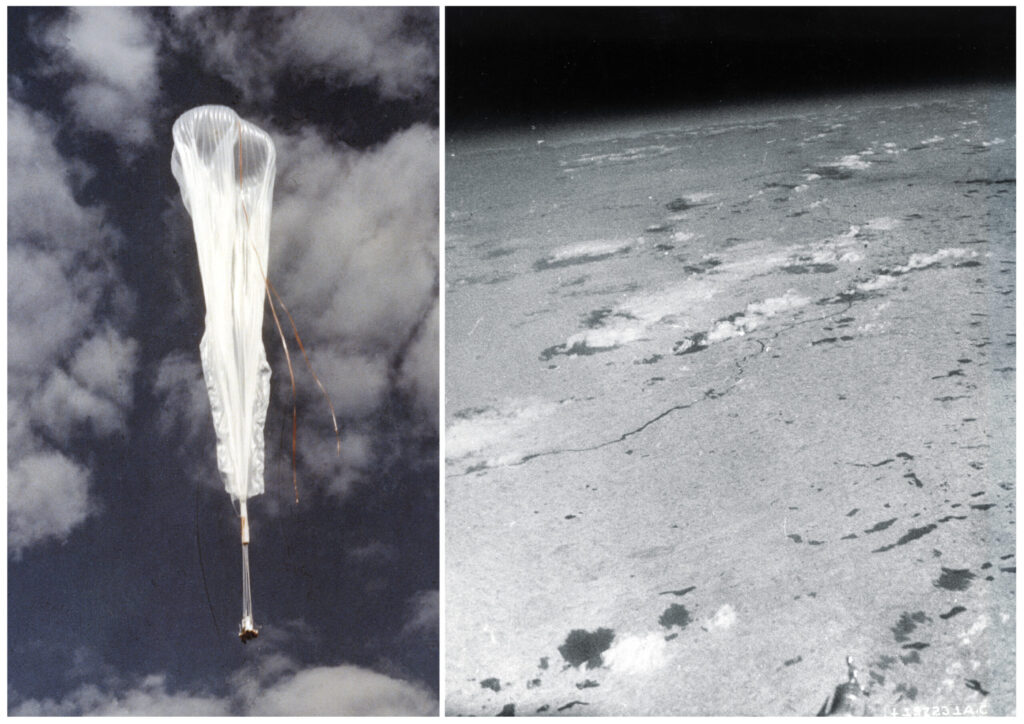
After a quick meal and some juice, McClure did a radio interview with a reporter. When it was over, he slumped back in his seat, feeling overtired. He started one of the experiments but reported feeling “really exhausted” and was told to rest a while.
Around 1:00 p.m., the ground team finally realized something was wrong with the pilot. His speech was slurred and his pulse rate was up to 140 beats per minute. The mounted thermometer now read 118 degrees but even a separate instrument to better record cabin temperature read 96 degrees. McClure’s core body temperature reached 101 degrees, then 102.3 degrees a half-hour later and he reported the cabin temperature as 96 degrees. The decision was made to terminate the flight and McClure was told to begin descent. He argued that he could continue for the planned duration but was overruled. As he passed 87,000 feet, his body temperature had risen to a very dangerous 104.1 degrees and the cabin was now 97 degrees. McClure’s heart rate reached 180 and he began hallucinating, seeing green splotches with his eyes open or closed. Complicating the matter further, he would now have to land in darkness, potentially making him harder to find. Additionally, the early landing could mean touching down in the San Andreas mountains west of Holloman.
Manhigh III, though, landed on a smooth area only a few miles from the launch point. McClure released the balloon instantly so that the capsule stayed upright, which was a first. The previous two pilots had not released the parachute early enough and the gondola had tipped over.
To everyone’s relief and amazement, not only did McClure survive, but he also climbed out of the gondola by himself and walked away without any assistance. As far as he was concerned, there had been no need for any worry, although his body temperature after landing was measured at 108.5 degrees. Someone less physically fit might not have survived. (McClure later applied for Project Mercury but was two inches too tall to fit in the spacecraft. He did end up working for NASA.)
Stapp wanted to follow up with a five-day flight, but the Air Force had no money for it in the budget. Even with only three flights, Manhigh’s research revealed that the radiation in the atmosphere’s upper reaches was not hazardous to humans exposed to it for a day or two. Another lesson learned from the project was how to transmit medical telemetry and the three flights demonstrated the need for future astronauts to possess great physical and mental stamina for emergency situations.
Manhigh was over but ballooning to the edge of space continued. The U.S. Navy conducted similar research, and the Air Force later sponsored additional projects. One of those was Excelsior, in which Joe Kittinger tested a parachute system from over 102,000 feet up. The lessons learned from the pioneering Manhigh program were of great benefit to these later ventures as well as to early manned spaceflight. Manhigh’s balloons hadn’t reached outer space—but they had come close.

